
3273
.pdf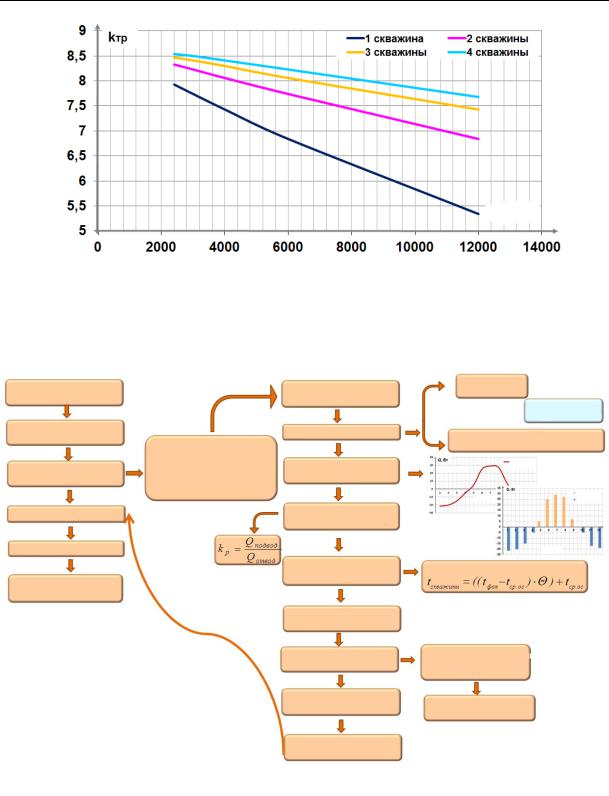
Russian Journal of Building Construction and Architecture
|
|
|
|
1 |
Well |
2 Wells |
|
3 |
Wells |
|
4 Wells |
Q, Watt
Fig. 4. Dependence of the conversion factor on the thermal load
The above technique can be represented as a block diagram (Fig. 5).
Collecting and analyzing |
|
Original |
|
|
Only heat |
|
|
|
|
supply |
|
||
the original data |
|
calculation data |
|
|
Only |
|
|
|
|
|
|||
|
|
|
|
|
|
conditioning |
Designing a technical task |
Method of calculating heat |
Choosing the operation mode |
|
|
Heat supply / conditioning |
|
|
|
|
|
alternation |
||
|
supply and conditioning |
Designing the graph of |
|
|
|
|
Formulating pre-project |
|
Q, Watt |
|
load on the object |
||
systems running on low- |
|
|
||||
|
|
|
|
|
Annual active |
|
solutions |
potential geothermal energy |
active loads |
|
|
|
|
|
|
|
|
|||
|
sources |
|
|
Conditioning |
Heat supply |
|
|
|
Calculating the |
|
Heat dissipation |
||
Arranging with the customer |
|
|
|
Month |
|
|
|
regeneration coefficient |
|
|
|
|
|
|
|
|
|
|
|
|
Designing systems |
|
|
|
|
|
Month |
|
Calculating the criterial |
|
|
|
|
|
|
|
Сonversion into the actual temperatures |
||||
Designing the project |
|
equations |
||||
|
|
|
|
|
||
|
|
|
|
|
|
|
report |
|
|
|
|
|
|
|
|
Calculating the |
|
|
|
|
|
|
construction equations |
|
|
|
|
|
|
Сalculating the number |
Сorrecting the number |
|||
|
|
of wells |
based on the regeneration |
|||
|
|
|
|
coefficient |
|
|
|
|
Identifying the efficiency |
|
|
design |
kp |
|
|
of the thermal pumping setup |
|
|
||
|
|
nWells = nwell |
||||
|
|
|
||||
Technical and economic calculation
Fig. 5. Method of designing heat supply and conditioning systems using the RES
Conclusions. Based on the research findings, a technique is set forth that forms a sequence of calculation and design of heating and air conditioning systems running on low-potential geothermal energy sources. It involves predicting the change in the temperature field during long-
50
Issue № 2 (50), 2021 |
ISSN 2542-0526 |
term operation of a low-potential energy source at the stage of design and preparation of design estimates. This technique enables effective calculation of the optimal number of geothermal wells, the necessary heat pumping equipment and reduction in the time of preparation of design documentation by minimizing the amount of capital and operating costs.
References
1. Vasil'ev G. P. Geotermal'nye teplonasosnye sistemy teplosnabzheniya i effektivnost' ikh primeneniya v klimaticheskikh usloviyakh Rossii [Geothermal heat pump systems of heat supply and efficiency of their application in climatic conditions of Russia]. AVOK. Teplosnabzhenie, 2007, no. 5. Available at: http://www.abok.ru/for_spec/articles.php?nid=3685.
2.Vasil'ev G. P. Teplokhladosnabzhenie zdanii i sooruzhenii s ispol'zovaniem nizkopotentsial'noi teplovoi energii poverkhnostnykh sloev zemli. Diss. d-ra tekh. nauk [Heat and cold supply of buildings and structures using low-potential thermal energy of the surface layers of the earth. Dr. eng. sci. diss.]. Moscow, 2006. P. 423.
3.Glasko A. V., Fedotov A. A., Sidinyaev N. I., Khrapov P. V., Mel'nikova Yu. S. Modelirovanie dinamiki temperaturnogo polya osnovaniya zdaniya v kriolitozone [Modeling of the dynamics of the temperature field of the building base in the cryolithozone]. Elektronnoe nauchno-tekhnicheskoe izdanie MGTU im. N. E. Baumana «Nauka i obrazovanie», 2011, no. 12. Available at: http://www.technomag.edu.ru/doc/274059.html.
4.Ibragimov E. V., Kronik Ya. A., Pustovoit G. P. Opyt ispol'zovaniya teplovykh nasosov v kachestve sistem termostabilizatsii grunta v kriolitozone [Experience of using heat pumps as systems for thermal stabilization of soil in the cryolithozone]. OFMG, 2015, no. 5, pp. 23––26.
5.Kozlov S. S., Kozlov E. S. Zavisimost' temperaturnogo polya grunta ot teploty, teryaemoi ograzhdayushchei konstruktsiei podzemnykh sooruzhenii [Dependence of the ground temperature field on the heat lost by the enclosing structure of underground structures]. Sovremennye naukoemkie tekhnologii, 2013, no. 8, pp. 302––304.
6.Poddubnyi G. V. Temperaturnoe pole v grunte pod izolyatsiei bespodval'nogo kholodil'nika [Temperature field in the ground under the insulation of the basement refrigerator]. Izv. vuzov. Matematika, 1962, no. 6, pp. 101––107.
7.Saprykina N. Yu. Povyshenie effektivnosti raboty sistem teplosnabzheniya i konditsionirovaniya, rabotayushchikh v komplekse s teplovym nasosom [Improving the efficiency of heat supply and air conditioning systems operating in combination with a heat pump]. Inzhenerno-stroitel'nyi vestnik Prikaspiya : nauchnotekhnicheskii zhurnal, 2018, no. 2 (24), pp. 17––23.
8.Saprykina N. Yu., Panov M. Ya. Issledovanie vliyaniya rezhimov raboty geotermal'noi skvazhiny s sistemami teplosnabzheniya i konditsionirovaniya v komplekse s teplovym nasosom na temperaturu gruntovogo plasta [Investigation of the influence of the operating modes of a geothermal well with heat supply and air conditioning systems in combination with a heat pump on the temperature of the ground layer]. Nauchnyi zhurnal stroitel'stva i arkhitektury, 2018, no. 4 (52), pp. 105––116.
9.Tarasova V. A., Kharlampidi D. Kh., Sherstyuk A. V. Modelirovanie teplovykh rezhimov sovmestnoi raboty gruntovogo teploobmennika i teplonasosnoi ustanovki [Simulation of thermal modes of joint operation of
51

Russian Journal of Building Construction and Architecture
a ground heat exchanger and a heat pump unit]. Vostochno-Evropeiskii zhurnal peredovykh tekhnologii, 2011, no. 5/8 (53), pp. 34––40.
10.Trushevskii S. N., Strebkov D. S. Vechnaya merzlota, osnovaniya i teplovye nasosy [Permafrost, bases and heat pumps]. Vestnik VIESKh, 2014, no. 4 (14), pp. 11––15.
11.Fedyanin, V. Ya., Karpov M. K. Ispol'zovanie gruntovykh teploobmennikov v sistemakh teplosnabzheniya [Use of ground heat exchangers in heat supply systems]. Polzunovskii vestnik, 2006, no. 4, pp. 98––103.
12.Fedyanin, V. Ya., Mikheev D. Ya. [Method of calculation of heat flows in a ground heat exchanger].
Materialy 61-i nauchno-tekhnicheskoi konferentsiya studentov, aspirantov i professorsko-prepodavatel'skogo sostava. Chast' 11. Energeticheskii fakul'tet [Materials of the 61st Scientific and Technical Conference of students, postgraduates and faculty. Part 11. Power Engineering Faculty]. Barnaul, Izd-vo AltGTU, 2003, pp. 12––14.
13.Shishkin N. D., Prosvirina I. S. Otsenka effektivnosti primeneniya teplonasosnykh ustanovok v sistemakh teplosnabzheniya Astrakhanskoi oblasti [Evaluation of the efficiency of heat pump installations in the heat supply systems of the Astrakhan region]. Izvestiya AZhKKh, 2000, no. 4, p. 7.
14.Diao N., Li Q., Fang Z. Heat transfer in ground heat exchangers with groundwater advection. Int. J. Therm. Sci., 2004, vol. 43, pp. 1203––1211.
15.Hellström G., Sanner B., Klugescheid M., Gonka T., Mårtensoon S. Experience with the borehole heat exchanger software EED. Proc. MEGASTOCK. Sapporo, 1997, pp. 247––252.
16.Hepbasli A., Key A. Review on exergetic analysis and assessment of renewable energy resources for a sustainable future. Renewable and Sustainable Energy Reviews, 2008, no. 12, pp. 593––661.
17.Monzó P., Acuña J., Mogensen P., Palm B. A study of the thermal response of a borehole field in winter and summer. International conference on applied energy ICAE, 2013, july, pp. 1––4.
18.Nordell B., Söderlund M. Solar energy and heat storage. Luleå University of Technology, 2000.
19.Ozgener O., Hepbasli A. Modelling and performance evaluation of ground source (geothermal) heat pump systems. Energy and Buildings, 2007, no. 39, pp. 66––75.
20.Papatheodorou N. G., Fragogiannis G. Ι., Stamataki S. Κ. Transient simulation of a hybrid ground sourse heat pump system. 3rd International Conference «From Scientific Computing to Computational Engineering» 3 rd IC-SCCE Athens, 2008, july, pp. 9––12.
21.Seyboth K., Beurskens L., Langniss O., Sims R.E.H. Recognising the potential for renewable energy heating and cooling. Energy Policy, 2008, no. 36, pp. 2460––2463.
52

Issue № 2 (50), 2021 |
ISSN 2542-0526 |
DESIGNING AND CONSTRUCTION OF ROADS,SUBWAYS,
AIRFIELDS,BRIDGES AND TRANSPORT TUNNELS
DOI 10.36622/VSTU.2021.50.2.004
UDC625.8
A. Alshahwan 1, Yu. I. Kalgin 2
IMPROVING THE STRUCTURAL AND MECHANICAL PROPERTIES
OF WARM ASPHALT CONCRETE
BY THE METHOD OF POLYMER-DISPERSE REINFORCEMENT
Voronezh State Technical University 1, 2
Russia, Voronezh
1РhD student of the Dept. of Design of Construction and Operation of Highways, e-mail: alaaalaash@yahoo.com 2 D. Sc. in Engineering, Prof. of the Dept. of Construction and Operation of Highways,
e-mail: kalgin36@yandex.ru
Statement of the problem. The problem of improving the structural and mechanical properties of warm asphalt concrete using the method of polymer-dispersed reinforcement is considered. The effect of the dosage of the RTEP-M modifier in the mineral part of the mixture on the structural and mechanical properties of warm mix asphalt (WMA) was studied.
Results. By preparing a warm mix asphalt with mixing and molding samples at a temperature of 110––120 °C with the RTEP-M modifier at a ratio of 0.5; 1.0; 1.5 and 1.75 % of the mineral part and control mixtures, the effect of the modifier dosage on the structural and mechanical properties of WMA was studied. By testing the samples, the compressive strength of warm asphalt concrete at temperatures of 0.20 and 50 °C was determined, as well as the indicators of average density, water saturation and water resistance.
Conclusions. The effectiveness of the application of the method of polymer-dispersed reinforcement to improve the structural and mechanical properties of warm concrete asphalt has been proven. It is shown that the addition of the RTEP-M modifier to the mineral part of the warm mix asphalt improves the strength characteristics of the asphalt concrete. It has been established that by applying the method of polymer-dispersed reinforcement, it is possible to optimize the properties of warm asphalt concrete for its use in cold or hot climatic conditions within the limits of indicators permissible according to the requirements of regulatory documents.
Keywords: warm mix asphalt, warm asphalt concrete, modifier, polymer-dispersed reinforcement, RTEP-M, structural and mechanical properties.
Introduction. For a long time, hot asphalt concrete mixtures (HAS) was the only type of asphalt concrete utilized for laying layers of asphalt concrete pavements, as in most countries HAS were chosen for constructing road networks of various categories and types [2, 10].
© Alshahwan A., Kalgin Yu. I., 2021
53
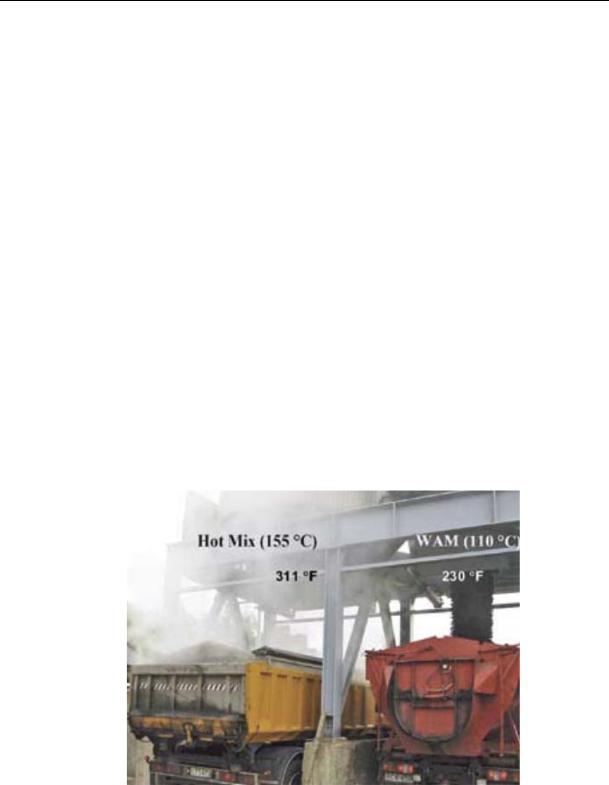
Russian Journal of Building Construction and Architecture
Relatively high temperatures during the production and use of this type of asphalt mixtures, a large amount of consumed fuel, greenhouse gas emissions, challenging operating conditions for employees [1, 4] and other factors called for an alternative technology for producing asphalt concrete mixtures. Therefore the recent years have seen an increase in the number of scientific studies, laboratory and field experiments in developing technologies for preparing warm asphalt mixes with properties not lower than those of hot asphalt mixes, in order for them to be used as an alternative in the construction of pavement layers.
Warm asphalt mixes are a type of asphalt mixes manufactured at temperatures lower than those of traditional hot asphalt mixes, by about 20––40 °C [9, 15, 16]. This is achieved by using various technologies for lowering the viscosity of bitumen, contributing to the lower temperatures required for the preparation and placement of asphalt mixes. A decrease in temperature causes a reduction in the amount of fuel required for heating materials at all stages of production, a decrease in emissions of harmful gases, an improvement in operating conditions and an extension of the road construction season. According to studies, compared to hot asphalt mixes, warm asphalt mixes reduce greenhouse gas emissions and energy consumption by about 33 % (Fig. 1) and 18 %, respectively [14, 19, 21].
Fig. 1. The difference in emissions of harmful substances into the atmosphere between hot and warm mixes: on the left is a hot mix, on the right is a warm mix [9]
Despite its multiple advantages, a number of flaws emerged in the technology of warm asphalt concrete mixtures during the period of its operation, the most critical one being the low
54
Issue № 2 (50), 2021 |
ISSN 2542-0526 |
water resistance (particularly while using water-based technologies) and the low values of mechanical properties of asphalt concrete, particularly while used in hot climates [2, 7]. The development of a technology for preparing TAS using simple production technologies and available local additives that improve the physical and mechanical properties of TAS will expand the application field of warm asphalt concrete.
Polymer-dispersed reinforcement [3, 5, 8] is known to be an effective method for improving the structural and mechanical properties of hot asphalt concrete is In these studies, the specified method was utilized with the use of RTEP-M as a modifier.
RTEP-M is a polymer dispersion-reinforcing modifier, which is a rubber thermoplastic elastomer that acts as a stabilizer and dispersion-reinforcing additive in asphalt concrete. RTEP-M is one of the well-known Russian additives containing recycled polyethylene, bitumen, stabilizers and other available materials.
Introducing RTEP-M into the mineral part of the warm asphalt concrete mix, we investigated the effect of the additive on the mechanical properties of asphalt concrete at high, low and natural temperatures, as well as its effect on the physical and chemical properties whose indicators were the average density, water saturation and water resistance of asphalt concrete.
1. Selection of the components of warm asphalt concrete mix and consideration of the properties of the used materials. The examined asphalt concrete mix is an asphalt concrete mix of type B, grade II.
For selecting the components of warm asphalt concrete mix in compliance with the requirements of GOST 9128-2009 «Asphalt Concrete Road, Airfield and Asphalt Concrete Mixes. Technical Conditions» with continuous grain composition, crushed stone of 5––20 mm fraction, sand from crushing screenings of 0––5 mm fraction and activated mineral powder were employed (grain compositions of materials for the mineral part of TAS are shown in Table 1).
|
|
|
|
|
|
|
|
|
|
|
Таble 1 |
|
|
|
Grain compositions of mineral materials |
|
|
|
|||||
|
|
|
|
|
|
|
|
|
|
|
|
Name |
|
|
|
Size of the grains, mm, finer, % of the mass |
|
|
|||||
|
|
|
|
|
|
|
|
|
|
|
|
20 |
15 |
|
10 |
5 |
2.5 |
1.25 |
0.63 |
0.315 |
0.16 |
0.071 |
|
|
|
||||||||||
|
|
|
|
|
|
|
|
|
|
|
|
Crushed stone |
95.6 |
71.9 |
|
26.2 |
1.2 |
0.15 |
0.0 |
0.0 |
0.0 |
0.0 |
0.0 |
|
|
|
|
|
|
|
|
|
|
|
|
Sand from crushing |
100 |
100 |
|
99.9 |
94.1 |
62.6 |
50.4 |
35.0 |
24.8 |
16.45 |
8.65 |
screenings |
|
||||||||||
|
|
|
|
|
|
|
|
|
|
|
|
|
|
|
|
|
|
|
|
|
|
|
|
Mineral powder |
100 |
100 |
|
100 |
100 |
100 |
100 |
100 |
100 |
96.0 |
87.0 |
|
|
|
|
|
|
|
|
|
|
|
|
55
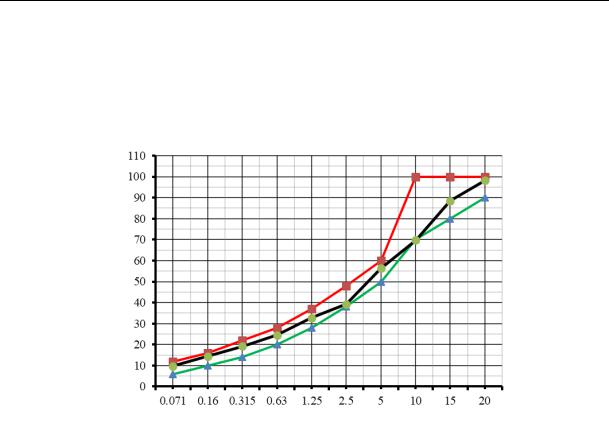
Russian Journal of Building Construction and Architecture
The grain composition of the mineral part is selected in compliance with the requirements of GOST 9128-2009. A mixture was selected which consisted of 41 % crushed stone, 53 % sand from crushing screenings and 6 % mineral powder [5]. Fig. 2 shows a particle size distribution curve for the mineral part of a warm asphalt mix.
Full cycle, %
Size of the grains of the mineral material, mm
Fig. 2. Grain size curves: max, min and actual grain size distribution, mm
The organic binder was BND 70/100 grade petroleum bitumen produced by Ltd. RNPK. This bitumen was liquefied using diesel fuel to obtain road bitumen BND 200/300 to be employed for preparing the TAS. The optimal content of bitumen (5 % over the mineral part) was identified in terms of physical and mechanical properties: average density, compressive strength, water saturation and water resistance [6, 11].
Table 2
Physical and Mechanical Properties of RTEP-M according to the STO 39952490-001-2020
Index |
Value, standard |
Testing method |
|
|
|
|
|
Physical appearance |
Freeform granules without any |
10.2 (STO 39952490-001-2020) |
|
inclusions; foaming is allowed |
|||
|
|
|
|
Colour |
Brown, black |
10.2 (STO 39952490-001-2020) |
|
|
|
|
|
Softening temperature, °С, no less than |
140 |
GOST 33142 |
|
|
|
|
|
Average granule size by the largest |
2––6 |
10.4 (STO 39952490-001-2020) |
|
dimension, mm |
|||
|
|
||
|
|
|
|
Bulk density, g/сm3 |
0.35––0.70 |
GOST Р 55419 |
|
|
|
|
56
Issue № 2 (50), 2021 |
ISSN 2542-0526 |
All of the components of the warm asphalt concrete mix complied with the requirements of the current regulatory and technical documentation.
Rubber thermoplastic elastomer RTEP-M complied with the requirements of STO 39952490- 001-2020 "Rubber Thermoplastic Elastomer RTEP-M. Technical Conditions". Its physical and mechanical properties are presented in Table 2.
The effect of the RTEP-M modifier on the structural and mechanical properties of asphalt concrete mixtures was evaluated by means of the ratio of the additive to the mineral part: 0.5; 1.0; 1.5 and 1.75.
2. Research methodology and testing results. The preparation of samples of warm asphalt concrete mixes, the testing and processing of the results were performed in the same fashion as for the hot asphalt concrete mixes, with the only difference being the temperatures of mixing and forming samples taken within 110––120 °C.
The TAS samples were prepared by heating mineral materials (crushed stone and sand from crushing screenings) of a specific mass to a temperature of 130 °C [17, 18]. Then mineral powder in a cold state was added and the mix was well mixed, after which road bitumen BND 200/300 was added at a temperature of 105––115 °C with all of the components mixed until well covered with bitumen [17].
For forming the samples, the temperature of the asphalt concrete mix was in the range of 110––120 °C [20, 22], the warm mix in the required amount was placed in preheated molds (while making the samples, the molds and inserts were heated to 90––100 °C), and then the mixture was compacted under load in compliance with GOST 12801-98 “Materials Based on Organic Binders for Road and Airfield Construction. Testing Methods”, after which the samples were removed from the molds and kept in air to be tested on the next day.
The specified sample preparation scheme was also implemented while using the RTEP-M modifier in TAS, which was introduced in a cold state by adding a mineral powder with thorough mixing of the mixture components and observing the steps discussed earlier [3, 8, 12, 13].
The sample testing procedure was performed in compliance with the requirements of GOST 12801-98. In order to determine the values of the indicators in each case, the arithmetic mean of the three test samples was taken.
The results of evaluating changes in the parameters of the mechanical properties of warm asphalt concrete while using the RTEP-M modifier in the mineral part of the mixture are shown in Fig. 3. According to these graphs (Fig. 3), as the percentage of RTEP-M additive increases, so does the value of the compressive strength of warm asphalt concrete in the entire range of
57
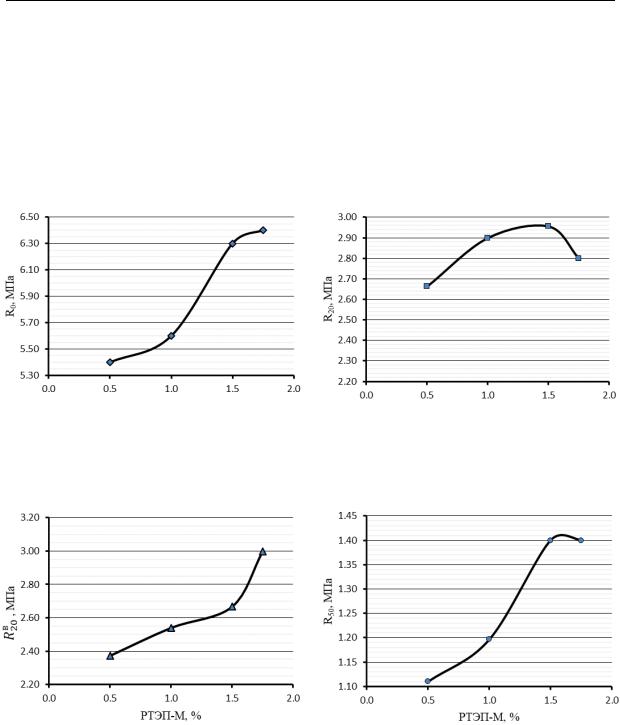
Russian Journal of Building Construction and Architecture
the temperatures. The value of the increase in the compressive strength index is most significant at 20 °C, while at the temperatures of 0 °C and 50 °C there is a slight increase. It should be noted that the value of the tensile strength in compression of warm asphalt concrete complies with the regulatory requirements for hot asphalt concrete of type B according to GOST 9128-2009 for the entire range of operating temperatures.
Compressive strength limit at the temperature 0 °C, МPа |
Compressive strength limit at the temperature 20 °C, МPа |
R0, MPa |
|
|
|
R20, MPa |
|
|
|
RTEP-M, %
Compressive strength limit at the temperature 20 °C in the water saturated state, МPа
|
|
, MPa |
MPa |
|
|
|
|
R50 |
|
|
RTEP-M, %
Compressive strength limit at the temperature 50 °C, МPа
RTEP-M, % |
|
RTEP-M, % |
|
|
|
Fig. 3. Influence of the content of the modifier RTEP-M on the mechanical properties of warm asphalt concrete
Indicators (water saturation, water resistance and average density of warm asphalt concrete) while using the content of the RTEP-M modifier in the mineral part of the mixture are shown in Fig. 4. The graphs indicate that the average density of warm asphalt concrete drops with an increase in the content of the RTEP-M modifier in the mineral part, particularly in the amount of 1 % or more. Water saturation with an additive content of 0.5––1 % drops slightly, and
58
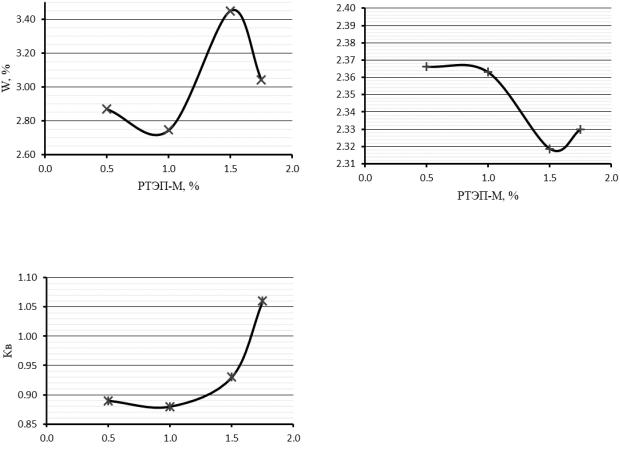
Issue № 2 (50), 2021 |
ISSN 2542-0526 |
then increases considerably with an increase in the dosage of RTEP-M to 1.5 %. The coefficient of water resistance increases as does the content of the modifier, which is particularly noticeable when its amount is 1% or more. It should be noted that the values of the indicators of these properties remain within the permissible limits according to the regulatory requirements for hot asphalt concrete of type B in compliance with GOST 9128-2009.
According to the results, the optimal content of RTEP-M in TAS is 1.5 % of the mass of mineral materials, as with such an amount of modifier, all of the indicators are in the range of good or the best values.
Water saturation, % |
Average density, g/сm3 |
ρm, g/sm3
|
RTEP-M, % |
|
|
|
RTEP-M, % |
||||
|
|
|
||
Water resistance coefficient |
|
|||
|
||||
Fig. 4. Influence of the content of the modifier RTEP-M on water saturation, water resistance and average density of warm asphalt concrete
RTEP-M, %
Conclusions
1. The preparation of the modified warm asphalt concrete mix with the improved mechanical and physical properties in compliance with the regulatory requirements is possible by means of using low viscosity road bitumen BND 200/300 obtained as a result of liquefaction of BND 70/100 bitumen in comparison with the hot production technology.
59
